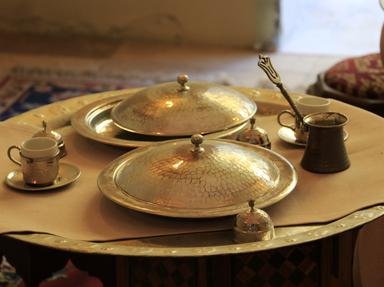Quiz Answer Key and Fun Facts
1. "Clean the hoof and pull its hair up..." So begins "Shanghai on the Internet's" recipe for camel hoof paste (intended for gourmet eating not for gluing objects together.) Today African immigrants in the Midwestern US consume camel meat imported from the last country in the world with wild Arabian camel herds. What country is that, mate?
2. You might want to reconsider tasting the candlenuts in the necklace you brought back from Hawaii. What toxin renders consumption of some candlenut varieties risky? (Hint: this poison is often described as having the odor of bitter almonds.)
3. The waiter reports to you the good news and bad news. "No sir, that is not a fly in your minestrone, but I regret to inform you that our cook left out the cannellini." What has been left out your soup? (Hint: If you're British or Canadian you'll have no trouble when the previous sentence has been reread enough times. Americans may have to think a bit more.)
4. If you're eating canapés, you're consuming a small piece of bread or a cracker with something savory on top. Had you been an ancient Greek eating a konops, what would you have been devouring? (Hint: the wrong answers won't bite you.)
5. You and a Massachusetts's friend have been exchanging recipes. In return for your "Limpin' Susan" recipe (containing no pieces of Susan whatsoever), your friend sends you his recipe for "Cape Cod Turkey". Which of the following is not a feature of the recipe for "Cape Cod Turkey"?
6. You and your young daughter sit beneath the spreading evergreen tree in your Hawaiian friend's yard. Noticing the tree's orange fruit, your daughter says, "Can I have one of those." Smiling, your friend picks one of the fruit, cuts it longitudinally, cuts a slice from the center and hands it to your daughter. Your daughter squeals in delight and rushes over to show you the shape that she sees in her slice of carambola fruit. What shape can be seen in a slice of carambola fruit? (Hint: Think Hollywood.)
7. The fruit of the caraway plant and the oil derived from it are used to flavor everything from the German liqueur "kummel" to toothpaste. However, an incorrect term is usually used for this fruit.
The unlearned I must now refute
And praise those who are more astute
For those with right reason
When with me they do season
Are not using my "_______" but my fruit.
What improper term is typically used for the fruit of the caraway plant?
8. Cardamom is said to have been the most popular spice in ancient Rome. Among spices, only saffron exceeds it in price. It is nicknamed "Grains of Paradise". Which of the following peoples utilized Cardamom in their religious rites?
9. A thick filet mignon is sliced open and stuffed with Sydney rock oysters that have been dipped in Worcester sauce. The steak is grilled rare and served, producing a dish popularized in Australia in the 1950s: carpetbag steak. However, Australia is not thought to have originated the carpetbag steak. To which country is that honor generally ascribed? (Hint: Think Rhett Butler and Scarlett O'Hara.)
10. Your accident-prone friend brings back a variety of plants for you to include in a salad claiming that they are "wild carrots". You remember hearing that wild carrots have an appearance similar to poison hemlock. Utilizing a botany field guide you are able to identify four different plants. But which of them are the wild carrots? (In order to give true trivia buffs an opportunity to distinguish themselves, the author will provide no hints for this final question.)
Source: Author
uglybird
This quiz was reviewed by FunTrivia editor
Bruyere before going online.
Any errors found in FunTrivia content are routinely corrected through our feedback system.

